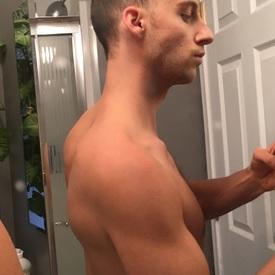Exercise for Lyme Disease and It's Residual Symptoms

ralrocky
Posts: 6 Member
Two and a half years ago I was finally diagnosed with having Lyme Disease. I probably had it for many years prior which had been improperly diagnosed by at least 3 doctors and maybe more depending on the specific symptom. Finally a wonderful doctor who has made an extensive study of Lyme properly identified my symptoms as Lyme-like, tested using an advanced lab test, and then treated it aggressively with the RIGHT combination of antibiotics. One of the serious symptoms that I experienced from an auto immune response to the infection has been CIDP, Chronic Inflammatory Demyelinating Polyneuropathy, or in more common parlance, peripheral neuropathy in my feet. To put it in even simpler terms, it causes tingling, burning, numbness, extreme sensitivity, and sometimes jabbing pin-prick pain and often all at once. This is the result of damage to the nerve sheaths that protects feet from everyday use. Diabetics often experience the same disorder. The impact of more than 15 minutes of walking at a slow pace can worsens the symptoms.
OK, enough with my sob story. I'm not a quitter. My neurologist encourages me to exercise saying it will increase my metabolism and efficiently encourage the blood flow of my weekly dose of medication aiding in the healing process. Here's the challenge. I'm not looking for sympathy but rather advice from those in similar circumstances who might have been able to design an exercise regimen for those who suffer from neurological disorders like mine or even others like MS or other central nervous system disorder patients. Walking or running is out of the question, but I've joined a gym and after 6 months have worked myself up to 30 minutes on the elliptical (painful, but no harsh foot impact), and 30 minutes of calisthenics, most of which are done on my back or stomach and some standing in place. I've lost weight, although welcomed but not a primary goal, and more importantly increased my heart capacity (takes longer on the elliptical to keep the heart rate at or under 105 than it did 4 months ago) improving my circulation.
Anyone out there with similar circumstance that might have further advice?
OK, enough with my sob story. I'm not a quitter. My neurologist encourages me to exercise saying it will increase my metabolism and efficiently encourage the blood flow of my weekly dose of medication aiding in the healing process. Here's the challenge. I'm not looking for sympathy but rather advice from those in similar circumstances who might have been able to design an exercise regimen for those who suffer from neurological disorders like mine or even others like MS or other central nervous system disorder patients. Walking or running is out of the question, but I've joined a gym and after 6 months have worked myself up to 30 minutes on the elliptical (painful, but no harsh foot impact), and 30 minutes of calisthenics, most of which are done on my back or stomach and some standing in place. I've lost weight, although welcomed but not a primary goal, and more importantly increased my heart capacity (takes longer on the elliptical to keep the heart rate at or under 105 than it did 4 months ago) improving my circulation.
Anyone out there with similar circumstance that might have further advice?
0
Replies
-
Yep totally been there! Have Lyme too. Been treating it for 4+ years. I have learned so much and have a ton of resources. Side note: if you wanna message me with any questions or just to talk in general add me and message me id be more than happy to talk with you more
 I know how hard it is, stick with it. Have you heard of rebounding? Essentially bouncing on a small trampoline gently to get a rhythmic motion, it will do wonders for improving blood flow and detox your body without being super physically demanding. Apparently one of the best methods for your lymphatic system to get flowing. Besides that just start going for walks, walk for 5 min for 7 days then go to 10 min for 7 days, then so on and so on. If you feel it's too much during or the next day or two, slow it down, allow your body to heal and detox then start back up again slower. Never push yourself outside of comfort zone, normally people that don't have Lyme would say push it lol but with us we really have to listen to our bodies and not overdue it since we are fighting a disease. I do light lifting of weights and walking mainly. I never work out two days in a row. I usually give myself 2-3 days rest after. In college I had a badminton class... thought I wasn't gunna be able to do it, first 2 weeks were terrible on my body but then I adjusted and it felt good to do. Unless I was sprinting multiple times in a row then I'd be out of breath and liver hurt from detoxing lol. Anyways just stick with walking and rebounding and work your way up slowly. On top of a proper diet, treatment regimen, detox methods, etc. I usually don't come back to threads so if you reply I won't see but like I said add me and message me if you'd like. Cheers. 0
I know how hard it is, stick with it. Have you heard of rebounding? Essentially bouncing on a small trampoline gently to get a rhythmic motion, it will do wonders for improving blood flow and detox your body without being super physically demanding. Apparently one of the best methods for your lymphatic system to get flowing. Besides that just start going for walks, walk for 5 min for 7 days then go to 10 min for 7 days, then so on and so on. If you feel it's too much during or the next day or two, slow it down, allow your body to heal and detox then start back up again slower. Never push yourself outside of comfort zone, normally people that don't have Lyme would say push it lol but with us we really have to listen to our bodies and not overdue it since we are fighting a disease. I do light lifting of weights and walking mainly. I never work out two days in a row. I usually give myself 2-3 days rest after. In college I had a badminton class... thought I wasn't gunna be able to do it, first 2 weeks were terrible on my body but then I adjusted and it felt good to do. Unless I was sprinting multiple times in a row then I'd be out of breath and liver hurt from detoxing lol. Anyways just stick with walking and rebounding and work your way up slowly. On top of a proper diet, treatment regimen, detox methods, etc. I usually don't come back to threads so if you reply I won't see but like I said add me and message me if you'd like. Cheers. 0 -
I had a full list of vector borne diseases that were un-diagnosed for years, including Lymes. I have fully recovered from the tick ailments now almost 15 years later, but I do still have two auto-immune diseases. It was a long, slow process to recovery. I don't have any residual neurological pain now, but since I was unable to walk and had severe pain for a long time one of the things that helped my mobility was yoga. I could barely do tree pose when I first started but the nice thing about yoga is even if you do it for 5 seconds, maybe next time you can hold it for 6 and you can gradually build up. I did at home yoga dvds because I would never have been able to keep up with a class. There are lots of videos out there that are yoga for recovery, some include chairs to help your stability. As soon as I felt pain in whatever position I was in, I stopped. It was a low impact way to help build up my strength. I then started doing more walking as I became more able to just move about my daily life.
I'm still not great at cardio since I have a higher heart rate, but I do lift weights now. The best advice I have is to just take it slow. If you try to push yourself too much in recovery, you'll end up going backwards. You don't need to match the athletic level of everyone else, just push yourself a little bit more each time at YOUR level so that you can push yourself a little more next time. If you try to do too much too soon, you'll just end up taking more rest days to recover.
Good luck! It does get easier, just keep at it!0 -
Thanks for the "easy does it" advice. Throughout my life I've been a "no pain, no gain" kind of guy but know now that recovery from Lyme and this horrid neuropathy will be LSD, long slow distance, as runners call it. I hate the setbacks, and the 8 hour infusions, twice a week, every other week has put my body and life into shutdown mode, but my Doc says to exercise through it all on my in between days just for the same reasons you cite, Gareberr. Thanks for the Yoga advice too, Annie. The gym I belong to has a yoga instructor and I will ask her if there's a way that someone with my limitations can learn it without holding back a class or pushing myself beyond my physical limitations. Again, thank you both.0
-
I just found this thread but I was diagnosed with Lyme a couple of months ago (but had an EM rash in December 2013). The thing that made me seek a doctor in late 2014 was permanent numbness and pain in my hands and feet. But then my symptoms started to slowly get better during the time we were doing tests, and the doc finally said that my body must have fought it off on its own, no treatment required. I find this odd but hope she is right. Anyways, throughout that time period and even now (I feel I have lingering issues, but it's not that bad, knock on wood), I do weightlifting and cardio on the recumbent bike. On good days I do the elliptical. With weights I actually lift pretty heavy, but very few reps, and never to failure. I do about 4 sets of 5 reps on each exercise. I make sure not to overdo it. And I have to exercise first thing in the morning because I'm pretty beat by late afternoon. I also put insoles into every pair of shoes I wear, including my workout shoes, called "super feet." Well, that's all I can think of for now.1
This discussion has been closed.
Categories
- All Categories
- 1.4M Health, Wellness and Goals
- 395.6K Introduce Yourself
- 44.1K Getting Started
- 260.7K Health and Weight Loss
- 176.2K Food and Nutrition
- 47.5K Recipes
- 232.7K Fitness and Exercise
- 446 Sleep, Mindfulness and Overall Wellness
- 6.5K Goal: Maintaining Weight
- 8.6K Goal: Gaining Weight and Body Building
- 153.2K Motivation and Support
- 8.2K Challenges
- 1.3K Debate Club
- 96.4K Chit-Chat
- 2.5K Fun and Games
- 4.3K MyFitnessPal Information
- 16 News and Announcements
- 1.3K Feature Suggestions and Ideas
- 2.9K MyFitnessPal Tech Support Questions


